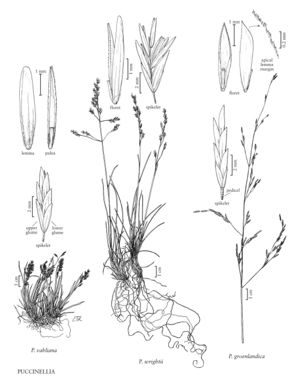Difference between revisions of "Puccinellia wrightii"
FNA>Volume Importer |
imported>Volume Importer |
||
| (3 intermediate revisions by 2 users not shown) | |||
| Line 43: | Line 43: | ||
|publication year= | |publication year= | ||
|special status= | |special status= | ||
| − | |source xml=https:// | + | |source xml=https://bitbucket.org/aafc-mbb/fna-data-curation/src/200273ad09963decb8fc72550212de541d86569d/coarse_grained_fna_xml/V24/V24_670.xml |
|subfamily=Poaceae subfam. Pooideae | |subfamily=Poaceae subfam. Pooideae | ||
|tribe=Poaceae tribe Poeae | |tribe=Poaceae tribe Poeae | ||
Latest revision as of 16:24, 11 May 2021
Plants perennial; cespitose, not mat-forming. Culms 15-40 cm, erect. Ligules 1.5-3 mm, acute to obtuse, entire; blades 2-8 mm wide, flat or folded. Panicles 5-8 cm, open and diffuse at maturity, lowest node usually with long branches, lower branches ascending, horizontal, or descending, spikelets usually confined to the distal 73; pedicels glabrous and smooth, lacking tumid epidermal cells. Spikelets 4-7 mm, with 4-5 florets. Glumes narrow, not enfolding the base of the lower lemmas, rounded over the back, veins obscure or distinct, apices acute to obtuse; lower glumes 1.7-3 mm, usually less than 2/3 as long as the adjacent lemmas; upper glumes 2.5-4 mm; rachilla internodes abruptly or gradually broadened to the point of attachment with the lemmas, at least the lowest internode usually more than 0.09 mm thick; calluses with a few hairs; lemmas 4-5 mm, mostly herbaceous, hairy along and between the veins on the proximal 1/2, backs rounded, 5-veined, veins obscure or distinct, not extending to the margins, apical margins hyaline, smooth, apices acute, entire, becoming erose with age; palea veins with curly, intertwined hairs proximally, these hairs rarely lacking, scabrous distally; anthers 1.5-2.5 mm. 2n = 14.
Discussion
Puccinellia wrightii is an uncommon arctic species. Its range extends from the Chukotka Peninsula in the Russian Far East to western Alaska. Like P. vahliana, its roots are characteristically thicker and more tightly curled than those of other Puccinellia species.
Selected References
None.
